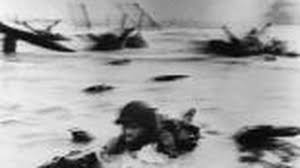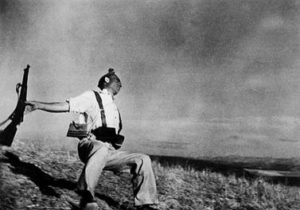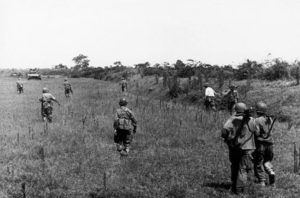For a long time, war photography was a rigid, almost static form of documentation. Photographers had big, bulky cameras, and they could rarely get close enough, or maneuver fast enough, to convey the action of battle.
But, in 1936, when Robert Capa went to Spain to cover the civil war, he took a 35mm Leica, which allowed him to plunge into the thick of things, to catch events on the run, and to search among soldiers and bystanders, the wounded and the refugees, for the one expression or gesture that would tell it all.
In so doing, he gave war a human face.
“If your pictures aren’t good enough, it’s because you didn’t get close enough,” said Capa, who covered five wars, and died in the last one because he got too close to a Vietminh land mine.

D-day picture from Omaha Beach.
Tragically, Capa was only 40 when he took his last picture of French soldiers fanning out across a grassy field in Vietnam in 1954. It’s amazing because he seems to have put his stamp on our century – or let it put its stamp on him – in a career that lasted little more than two decades.
Now, Capa’s best photographs can be seen at the International Center of Photography’s Midtown Gallery in a show that reveals a photographer of surprising emotional range. Capa was no mere sensationalist, no scavenger of human misery. He produced many pictures of lyrical tenderness and outright exuberance, the kinds of things associated with more overtly artistic photographers like his friends Andre Kertesz and Henri Cartier-Bresson.
Capa is something of a legend among photographers, like a character in a Hemingway novel come to life. Born Endre Friedman in Budapest, Hungary, in 1913, he invented Robert Capa – a glamorous and successful American photographer – in order to sell his work to French photo agencies. When the ruse was discovered, he simply became Capa. The pictures were that good.

Staged or real? Capa’s photo of Spanish Loyalist militiaman at the moment of death has been questioned by scholars.
He and the great love of his life, German photographer Gerda Taro, went to Spain to photograph the war – not just for journalistic ends, but, like many idealists of their generation, to enlist support for the Loyalist movement. Taro was killed there in 1937, a loss, it is said, from which Capa never fully recovered. But the photographs he made there gained him an international reputation. One gallery of the exhibit is devoted to photographs taken by Taro and Capa when they were together.
Capa lived Paris’ movable feast in the Thirties and after the war. He was a friend of Hemingway’s (when the writer cracked up his car on the way back from a Capa party, Capa photographed him, head bandaged, in his hospital bed). He knew Picasso and Matisse, traveled with Steinbeck, hobnobbed with Gary Cooper and Humphrey Bogart, fell in love with Ingrid Bergman, waded onto Omaha Beach with the soldiers on D-day, saw the liberation of his beloved Paris, and witnessed the founding of the state of Israel. Even his death in the Indochina war seemed a portent of the tragedy that would involve his adopted country in the decades after his death.
Capa’s great gift was to find the Everyman amid the chaos of war. It’s easy to forget, in looking at these pictures, that life – real life – doesn’t pose for anyone. Capa could give us a sense of perilous action, the split second when a bullet ended a life, or, he could find the story on the perimeter, among the forgotten people, the wounded civilians, the hopeful refugees, the children playing in rubble.

Capa’s last frame. It was taken just before his death from an exploding landmine in Thai Binh, Vietnam on 25th May 1954.
The exhibit resolves a controversy over Capa’s most famous image, that of a Spanish Loyalist militiaman at the moment of death. In the mid-1970s, a British journalist suggested that Capa’s image was made during a staged event, a simulated battle put on by Franco’s troops. But subsequent documentation – presented in an exhibit pamphlet and in a film on Capa – appears to prove the photo was real. Capa’s whereabouts, the place and day it occurred – even the identity of the soldier – have all been determined, and the photo now carries the scholarly title “Death of a Loyalist Militiaman (Federica Borrell Garcia), Cerro Muriano (Cordoba Front), 1936.”
Viewing the picture, which, like many here, originally appeared in Life magazine, it’s hard to see how anyone could doubt its veracity. The man is literally stopped by the bullet, his legs advancing down the hill, but his upper body blown back by the impact. It’s not a glamorous, Hollywood death. He’s dead before he can even bleed, before his limp body hits the ground. In his shirtsleeves and his billowing pants, he doesn’t even look like a proper soldier, just an ordinary man, brave but ill-equipped, who dies in a losing cause. Often called the greatest war picture ever taken, it looks now like a warning to a naive world about the ruthlessness of fascism.
Capa’s pictures were often made on the run, flawed by graininess, blurriness, poor cropping. And, yet, these technical details seem beside the point and often add drama to the picture. In his photo of a woman in Barcelona racing for shelter in an air raid, the backround is a blur, the dog bounding beside her is a blur; only the woman is in focus. And so, the viewer becomes her, hears the clatter of her heels on the pavement, the yip of the dog, the blare of the sirens.
Similarly, in his D-day picture from Omaha Beach, the thin-faced GI inching forward in the shallow water is all a blur, not from his own minimal movement but from Capa’s, who waded in with the troops as “bullets tore holes in the water around me,” and who, unlike the soldier, must have had to get momentarily upright, to take this picture. Sadly, only 11 of Capa’s D-Day pictures survived; the rest were destroyed by an overeager lab technician in a London studio.
So much of photography’s power is in its ability to capture a moment, a split second in time. This is obvious when the event itself is only of a moment’s duration, like the death of the militiaman, but Capa also knew to put something fleeting in his pictures of non-urgent events, to give them a sense of immediacy. In his simple 1936 picture of four Parisian boys tossing pieces of debris from a crumbling wall, each is a bit off balance, caught in a stage of action, throwing, bending, running, or transfixed by the actions of another.
There is, throughout Capa’s pictures, a sense of human courage, resilience, and adaptiveness. The vast majority of his pictures are not of death itself, but of survivors struggling to go on, often carrying their wounded relatives. In a picture taken during the London blitz, an English couple in the Underground prepares a makeshift formal tea. A little girl rushing along the streets with her mother during an air raid has, in the excitement, buttoned her coat unevenly. And, Capa had pity for those on the other side of wars, as can be seen in a picture of a crowd taunting a French woman – her head shaved in punishment for bearing the child of a German soldier during the occupation – as she cradles her baby in her arms.
Although he was a brave man who risked his life in war countless times, he was something of a pacifist who used to say that he looked forward to the day when he wouldn’t be able to find employment as a war photographer. It seems fitting that he was buried in a Quaker cemetery.

